Printing Women: Valerie Hammond
While the exhibition Printing Women focuses on Henrietta Louisa Koenen’s (1830–1881) collection of female printmakers from the 16th to 19th centuries, it is only appropriate to signal women’s continuing participation in the medium as well as the Library’s longstanding commitment to acquiring and exhibiting prints made by women from around the world. To complement this earlier history, therefore, I worked with the Library’s Digital Experience Team to display online a small sampling of works by contemporary printmakers in the Library’s collection. We began reaching out to artists, asking if we could display their work on the exhibition’s web page and digitize it for our digital collections. The majority were delighted to contribute, many also provided writings about their work and the exhibition. Throughout the exhibition’s run, I will choose and present a piece by one artist every other week on the exhibition’s web page. Additionally, I will produce a blog post about their work as well as about works in the exhibition, featuring their own words when possible.
For those who are interested in the long history of women’s involvement with the medium of print, there is much more to explore within the Library’s deep and varied holdings. The exhibition features only a smattering of Koenen’s collection (which numbers over 500 prints of which only a little over 80 are shown in the exhibition). In addition, the Print Collection not only owns large numbers of additional prints from the period in which Koenen collected, but also many, many more works from the 20th- and 21st-century.
The fifth blog post in our series is by Valerie Hammond about her piece, Blue Anemone, 2011.
"Blue Anemone, made in 2011, was the result of a special collaboration with printmaker Maryanne Simmons of Wildwood Press, but the image’s origins stemmed from a group of works I began a decade before.
I started making tracings of hands in the late 1990s, partly in response to the death of a dear friend from AIDS, whose beautiful hands I often found myself remembering. Mostly traced from women and children, each of the hand images was unique, an attempt at capturing the essence of a gesture and the fleeting moment in which it was made. Around the same time, in 1998, I was invited to teach printmaking at Yale University’s Norfolk summer program. Like many of the women in the exhibition I worked within the confines of children and family. My then young children came with me, and we spent time in the nearby woods, making fairy houses out of moss and ferns. I collected and pressed various fern fronds, attracted to their spindly forms and primordial origins.
I soon began assembling the ferns inside the traced hands, securing them with layers of wax, their stems and fronds echoing the body’s bones, veins and circulatory systems. Ferns, and then other plants, became both the material and “tools” for drawing, subverting traditional markmaking methodologies. Later, I introduced printmaking, drawing and photographic techniques, like the Xerox transfer process, to the compositions, in order to further manipulate and “distance” the imagery. One night, experimenting in Photoshop, I accidentally inverted some of the images: the background darkened into a deep blue and the plant material turned ghostly white. The works suddenly inhabited a space I had been searching for, straddling the indefinable boundary between presence and absence, material and immaterial, consciousness and the unconscious. For me, they became emblematic not only of those whose hands I had traced, but of my own evolving artistic process – testimony to passing time and the quiet dissolution of memory.
.jpg)
Simmons first invited me to make prints at her St. Louis studio in 2006. Her huge presses enabled me to work at an unprecedented scale, with unprecedented freedom, and I developed a series of large, relief printed lithographs from my hand tracings. While I was working at Wildwood Press, a close friend of Maryanne’s, Courtney, who at the time wore a bright pink wig, impressed me by her warmth and instant understanding of my process. My experience at Wildwood was rich and very meaningful; it was a collaborative environment among likeminded women. Years later Maryanne told me that Courtney was terminally ill. Before Courtney died, Maryanne asked her son to trace her hands, knowing that Courtney would understand why. Maryanne then sent the tracings to me and asked me to begin a piece using her hands. As I set out looking for materials I came across some ethereal blue anemones in the garden. It turned out they were Courtney’s favorite flower. She passed away before the print, Blue Anemone, was finished.
Women artists and printmakers have long been a huge influence on me. Obvious associations can be seen in Victorian botany photographs, like those of Anna Atkins, and the prints and watercolors of Maria Sybilla Merian. More immediately, I am indebted to the fearlessness of Louise Bourgeois, the political feminism of Nancy Spero, and the close friendship and collaboration I have with Kiki Smith, where we have spent many hours teaching printmaking together as well as working in various print shops together joyfully scratching on copper. "
Read E-Books with SimplyE
 With your library card, it's easier than ever to choose from more than 300,000 e-books on SimplyE, The New York Public Library's free e-reader app. Gain access to digital resources for all ages, including e-books, audiobooks, databases, and more.
With your library card, it's easier than ever to choose from more than 300,000 e-books on SimplyE, The New York Public Library's free e-reader app. Gain access to digital resources for all ages, including e-books, audiobooks, databases, and more.
If you don’t have an NYPL library card, New York State residents can apply for a digital card online or through SimplyE (available on the App Store or Google Play).
Need more help? Read our guide to using SimplyE.

